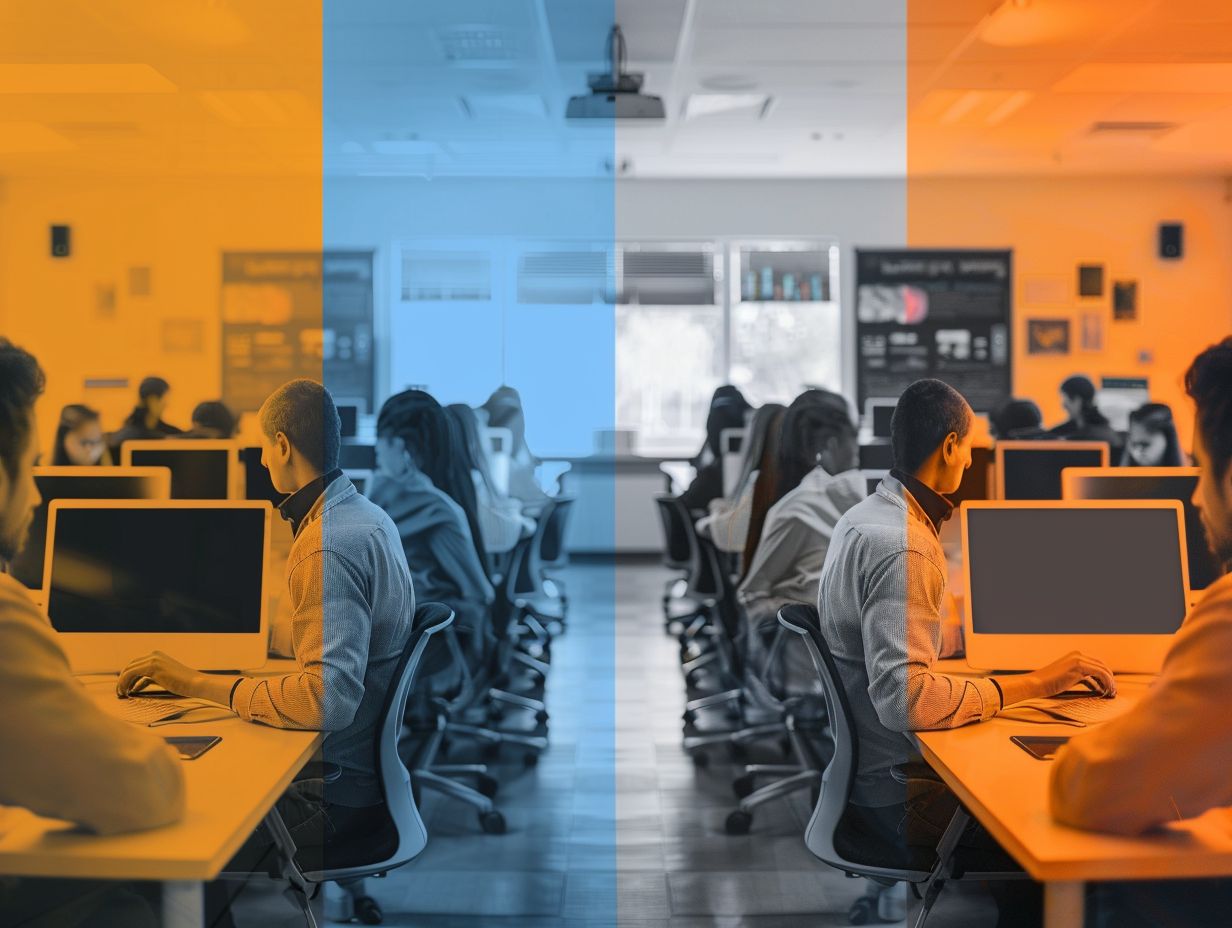If you are looking to enhance your technical skills but are uncertain about the best learning method for you, the definitions and key differences between synchronous and asynchronous technical learning will be explored.
The advantages of synchronous learning, such as real-time interaction and structured learning environments, will be discussed, as well as the disadvantages, including limited flexibility and potential technical issues.
Additionally, we will delve into the benefits of asynchronous learning, such as flexibility and self-paced learning, along with the drawbacks, including lack of real-time interaction and challenges with self-motivation.
By the end of this article, you will have a better understanding of both learning methods and be equipped to choose the right one for your needs.
Key Takeaways:

Understanding Synchronous and Asynchronous Technical Learning
Understanding Synchronous and Asynchronous Technical Learning is essential in modern education and training.
In Synchronous learning, immediate feedback and collaboration are facilitated among participants, making it particularly well-suited for activities requiring real-time engagement such as virtual classrooms, webinars, and live online discussions. On the other hand, Asynchronous learning provides flexibility as learners have the freedom to study and complete assignments at their convenience, which is beneficial for self-paced online courses, recorded lectures, and discussion boards. The key distinction between the two lies in the timing of instruction delivery and interaction.
Examples of synchronous learning include live online workshops conducted by industry experts, while examples of asynchronous learning encompass pre-recorded training modules often utilized in employee onboarding programs.
Definitions and Key Differences
Understanding the Definitions and Key Differences between Synchronous and Asynchronous Technical Learning is essential for both students and instructors.
In Synchronous learning, active participation in live discussions is encouraged, fostering a sense of community and improving teamwork among learners. Conversely, Asynchronous learning provides greater independence and the opportunity for deeper reflection on course content.
One of the advantages of Synchronous learning is the immediate clarification of doubts, while Asynchronous learning allows individuals to tailor their study schedules to their personal commitments.
Challenges such as time zone differences and technical issues may arise in Synchronous learning, whereas maintaining motivation and staying on track with deadlines can be hurdles in Asynchronous learning.
Advantages of Synchronous Technical Learning
The benefits of Synchronous Technical Learning are evident in its real-time interactions and feedback mechanisms. You, as a student, can reap the advantages of receiving immediate responses from instructors, participating in structured learning environments, and engaging in sessions that promote active involvement.
Through synchronous learning, you have the opportunity to ask questions as they arise, receiving instant clarification and feedback. This immediate loop of communication aids in enhancing your comprehension of intricate technical concepts, keeping you aligned with your learning objectives.
Structured learning environments within synchronous classes offer you a clear path through the curriculum, ensuring systematic progression in your studies. The active engagement encouraged by synchronous sessions motivates you to participate in discussions, group activities, and problem-solving tasks, facilitating a collaborative and interactive learning atmosphere.
Real-Time Interaction and Feedback
Real-Time Interaction and Feedback in Synchronous Technical Learning fosters dynamic engagement between you as a student and your instructors. This immediate exchange of information allows for clarifications, discussions, and personalized responses that enhance your learning experience.
Enabling you to ask questions and receive instant responses, real-time interaction cultivates a sense of community within technical education environments. Through platforms like virtual classrooms, video conferencing, and instant messaging tools, you can actively participate in discussions, collaborate on projects, and receive timely feedback from instructors. These tools not only bridge the physical gap between learners and educators but also create a supportive and interactive learning ecosystem that accelerates knowledge transfer and promotes active student engagement.
Structured Learning Environment
Structured Learning Environment is a key advantage of Synchronous Technical Learning. It provides you with a well-organized framework for course delivery, clear scheduling of sessions, and direct interaction between instructors and students.
This type of structured setup ensures that you know what to expect from each session, helping you stay focused and engaged throughout the learning process.
For example, having a designated time for Q&A sessions after each lesson allows you to clarify doubts immediately, leading to a more comprehensive understanding of the material.
Clear guidelines for assignments and deadlines within the structured environment help you manage your time effectively and maintain a steady progression in your learning journey.
Disadvantages of Synchronous Technical Learning

When utilizing Synchronous Technical Learning, you may experience drawbacks such as limited flexibility in scheduling and potential technical disruptions that can impact your learning sessions. As a student, you might encounter difficulties in adjusting to fixed schedules and encounter connectivity issues or platform-related challenges.
The inflexibility of synchronous learning systems can pose challenges for students who require more customized learning approaches or have varying time limitations. The demand to maintain a set pace may lead to feelings of overwhelm and impede the comprehension of complex subjects. Conflicting scheduling constraints with other commitments can create time constraints and reduce overall engagement. To tackle these issues effectively, it is crucial for educators to incorporate strategies that enhance interaction, encourage active involvement, and offer alternative channels for content delivery.
Limited Flexibility
Limited Flexibility poses a significant challenge in Synchronous Technical Learning as it hinders your ability to effectively manage your schedule. Fixed class timings and synchronous sessions can potentially clash with other commitments you may have.
This lack of flexibility often results in heightened stress and challenges for you in juggling academic responsibilities alongside personal and professional obligations. Consequently, you may feel overwhelmed and find it difficult to actively participate in synchronous learning activities.
To tackle this issue, educators and institutions could explore offering a combination of live sessions and pre-recorded materials, enabling you to access course content at your convenience. Embracing a more asynchronous approach can furnish you with the flexibility required to engage with the material efficiently while accommodating your diverse schedule and commitments.
Potential Technical Issues
Potential Technical Issues pose a risk in Synchronous Technical Learning, as connectivity problems, platform glitches, or hardware issues can disrupt your learning process. Both you as a student and your instructors may encounter challenges when technology fails during real-time sessions.
These technical disruptions can lead to frustration and a loss of valuable learning time. To address connectivity issues, ensure a stable internet connection and use wired connections instead of Wi-Fi to enhance reliability. Keeping software and firmware up to date can prevent platform glitches.
In case of hardware failures, have backup devices ready as a precaution. Practicing troubleshooting techniques beforehand and having a backup plan in place can help you swiftly tackle any unexpected technical hiccups, ensuring a smoother synchronous learning experience.
Advantages of Asynchronous Technical Learning
The advantages of Asynchronous Technical Learning center around flexibility and self-paced learning opportunities. You can benefit from accessing course materials at your convenience, progressing through modules at your own speed, and receiving feedback asynchronously.
Asynchronous learning accommodates various learning styles, allowing you to engage with the content in a manner that suits your preferences. This approach supports independent study in technical fields by enabling you to delve deeper into concepts, revisit materials as needed, and investigate topics of interest at your own pace.
Asynchronous learning offers a level of autonomy that fosters critical thinking and problem-solving skills, as you take ownership of your education and drive your learning experiences.
Flexibility and Self-Paced Learning
Flexibility and self-paced learning represent key advantages of Asynchronous Technical Learning. By adopting this approach, you can effectively manage your time and proceed through course materials at your own pace. This method offers you the liberty to interact with educational content based on your unique preferences and timetable.
This autonomy nurtures a sense of accountability for your education, which in turn fosters a deeper understanding and retention of concepts. By setting your own speed, you can allocate additional time to challenging subjects while swiftly navigating through familiar ones. The incorporation of various tools like interactive quizzes, discussion forums, and multimedia resources further enriches the self-paced learning experience. For example, platforms such as Khan Academy provide students with tailor-made learning paths, enabling them to concentrate on areas requiring improvement while swiftly progressing through mastered content.
Accessibility and Convenience
In Asynchronous Technical Learning, accessibility and convenience hold significant importance as they provide students with the flexibility to retrieve course materials from any location and at any time. This adaptability not only enriches the learning experience but also caters to a wide range of schedules and preferences.
The seamless availability of educational resources enables students to interact with the material at their preferred pace, thereby facilitating a more personalized learning journey. By transcending the traditional time limitations of in-person classes, learners can delve into complex subjects, review challenging concepts, and gain a thorough understanding of the content. The convenience of remote learning nurtures independence and self-discipline, critical qualities that can lead to enhanced learning outcomes and a more student-centric approach to education.
Disadvantages of Asynchronous Technical Learning

The disadvantages of Asynchronous Technical Learning for you include the absence of real-time interaction, as well as challenges related to self-motivation and time management. You may find it difficult to stay motivated without immediate feedback and experience challenges in effectively managing your study schedules.
Furthermore, the lack of face-to-face interaction in asynchronous learning environments can result in feelings of isolation and disconnection from both instructors and peers. This deficiency in interpersonal communication may hinder the development of collaborative skills and impede the exchange of ideas, which are crucial elements of a comprehensive educational experience.
Additionally, individuals engaged in asynchronous learning often struggle to maintain a structured approach to their studies. The flexibility offered by online coursework can sometimes blur the lines between academic responsibilities and personal commitments, making it challenging for students to adhere to a consistent study routine.
Lack of Real-Time Interaction
The lack of Real-Time Interaction poses a significant challenge in Asynchronous Technical Learning. Students risk missing out on immediate feedback and collaborative discussions, which can ultimately impact the depth of their learning experience and overall social interaction with peers.
When students are unable to engage in real-time discussions, they face potential delays in receiving feedback on their work. This delay can hinder their progress and limit their understanding of the material. Additionally, the absence of spontaneous interaction may impede the development of critical thinking skills and the opportunity to exchange ideas with classmates.
To tackle this issue effectively, educators should consider implementing alternative methods in asynchronous learning environments. These methods may include setting up discussion forums, organizing virtual office hours, assigning peer feedback tasks, and incorporating interactive simulations. By utilizing these approaches, educators can create a platform that fosters meaningful interactions and enhances the overall learning experience for students.
Self-Motivation and Time Management Challenges
When facing Asynchronous Technical Learning, you encounter hurdles related to self-motivation and time management. It’s essential for you to take the initiative to engage with course materials and effectively organize your study schedules in this independent learning environment. Without immediate guidance and set timelines, you may find it challenging to maintain a consistent learning pace.
To address these obstacles, it is crucial that you recognize the significance of establishing realistic goals and structuring a routine that supports regular study sessions. One beneficial approach involves creating a dedicated study area free from distractions, enabling you to concentrate fully on your learning tasks. Additionally, leveraging organizational tools like calendars, to-do lists, and task management applications can assist you in prioritizing your commitments and meeting deadlines effectively.
By breaking down larger tasks into smaller, more manageable segments, you can prevent feelings of overwhelm and boost your productivity within asynchronous learning settings. This strategic approach allows you to navigate the complexities of independent study with greater ease and efficiency.
Choosing the Right Learning Method for You
When choosing the right learning method for you, it is important to consider various factors such as your learning preferences, schedule flexibility, and interaction needs.
Whether you opt for synchronous or asynchronous technical learning, selecting the method that aligns with your goals and learning style is crucial for a successful educational experience.
Synchronous learning involves real-time interaction with instructors and classmates, providing immediate feedback and following a structured timetable. On the other hand, asynchronous learning offers flexibility by allowing students to access course materials at their convenience, promoting self-paced learning.
Evaluating your availability and preferred mode of interaction is crucial in making this decision. Consider your comfort level with technology, as asynchronous learning often requires independent navigation of online resources. Reflect on your desired pace of learning and how you learn best whether through collaborative discussions in synchronous sessions or independent study in an asynchronous setting.
Factors to Consider
When choosing the right learning method, factors to consider include your preferred mode of interaction, time availability, and learning style. Evaluate whether you thrive in real-time engagements or prefer self-paced progress to determine which learning approach suits your academic and professional needs.
When deciding between synchronous and asynchronous learning methods, consider your scheduling constraints. If you have a busy or unpredictable schedule, asynchronous learning might offer more flexibility, allowing you to study at your own pace. On the other hand, if you value immediate feedback and collaboration, synchronous learning could be more beneficial. It’s essential to align your personal commitments with the demands of each learning mode.
Reflect on your learning style – whether you prefer active participation in group discussions or solo exploration through course materials. Understanding these facets will help you create a decision-making framework tailored to your unique preferences.
Frequently Asked Questions
What is the difference between synchronous and asynchronous technical learning?

Synchronous technical learning refers to real-time learning where students and instructors are present at the same time, while asynchronous technical learning allows students to access learning materials and complete assignments at their own pace.
What are the pros of synchronous technical learning?
Some pros of synchronous technical learning include the ability to ask questions and receive immediate feedback, the opportunity for live interaction and collaboration with instructors and peers, and the structure and accountability provided by a set schedule.
What are the cons of synchronous technical learning?
Some cons of synchronous technical learning include the potential for technical difficulties and connectivity issues, the need to adhere to a set schedule which may not be convenient for all students, and the lack of flexibility for students with busy schedules.
What are the pros of asynchronous technical learning?
Some pros of asynchronous technical learning include the flexibility to access learning materials and complete assignments at any time, the ability to work at one’s own pace, and the potential for self-directed learning.
What are the cons of asynchronous technical learning?
Some cons of asynchronous technical learning include the lack of immediate feedback and interaction with instructors and peers, the potential for procrastination and lack of accountability, and the need for strong time-management skills.
Which type of technical learning is better for me?
The answer to this question depends on your personal learning style and preferences. Some students may thrive in a synchronous learning environment, while others may prefer the flexibility and independence of asynchronous learning. It is important to consider your needs and goals when deciding which type of technical learning is best for you.
